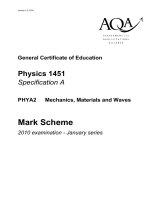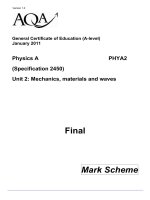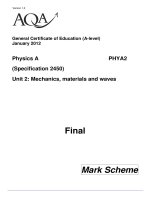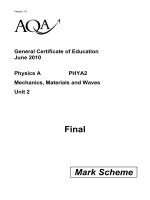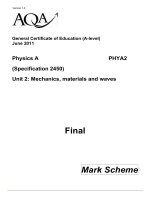AQA ANTH1 w MS JUN13
Bạn đang xem bản rút gọn của tài liệu. Xem và tải ngay bản đầy đủ của tài liệu tại đây (96.38 KB, 15 trang )
v1.0.
General Certificate of Education
June 2013
1111
Anthropology
ANTH1
Being Human:
Unity and Diversity
Unit 1
Final
Mark Scheme
Mark schemes are prepared by the Principal Examiner and considered, together with the
relevant questions, by a panel of subject teachers. This mark scheme includes any
amendments made at the standardisation meeting attended by all examiners and is the scheme
which was used by them in this examination. The standardisation meeting ensures that the
mark scheme covers the students’ responses to questions and that every examiner
understands and applies it in the same correct way. As preparation for the standardisation
meeting each examiner analyses a number of students’ scripts: alternative answers not already
covered by the mark scheme are discussed at the meeting and legislated for. If, after this
meeting, examiners encounter unusual answers which have not been discussed at the meeting
they are required to refer these to the Principal Examiner.
It must be stressed that a mark scheme is a working document, in many cases further
developed and expanded on the basis of students’ reactions to a particular paper. Assumptions
about future mark schemes on the basis of one year’s document should be avoided; whilst the
guiding principles of assessment remain constant, details will change, depending on the content
of a particular examination paper.
Further copies of this Mark Scheme are available to download from the AQA Website: www.aqa.org.uk
Copyright © 2013 AQA and its licensors. All rights reserved.
COPYRIGHT
AQA retains the copyright on all its publications. However, registered schools and colleges for AQA are permitted to
copy material from this booklet for their own internal use, with the following important exception: AQA cannot give
permission to schools or colleges to photocopy any material that is acknowledged to a third party even for internal
use within the school or college.
Set and published by the Assessment and Qualifications Alliance.
The Assessment and Qualifications Alliance (AQA) is a company limited by guarantee registered in England and Wales (company number 3644723) and a registered charity (registered charity number 1073334).
Registered address: AQA, Devas Street, Manchester M15 6EX
Anthropology ANTH1 - AQA GCE Mark Scheme June 2013
QUALITY OF WRITTEN COMMUNICATION
Where students are required to produce extended written material in English, the scheme of
assessment must make specific reference to the assessment of the quality of written
communication. Students must be required to:
•
•
•
ensure text is legible, and spelling, grammar and punctuation are accurate, so that meaning
is clear
select and use a form and style of writing appropriate to purpose and complex subject
matter
organise relevant information clearly and coherently, using specialist vocabulary when
appropriate.
The assessment criteria for quality of written communication apply to the assessment of the
20-mark questions. The following criteria should be applied in conjunction with the mark
scheme.
The quality of written communication bands must be regarded as integral to the appropriate
mark scheme band, even though they are listed separately in the mark scheme. Examiners
should note that, in the assessment of students’ anthropological knowledge and skills, the
assessment of the Quality of Written Communication will be judged through the assessment of
the clarity and appropriateness of the anthropological material presented.
For 10-mark questions
In the 1 – 3 band, students’ answers are likely to be characterised by the poor logical
expression of ideas and the use of a limited range of conceptual terms, perhaps often used
imprecisely and/or inaccurately. Spelling, punctuation and grammar may show serious
deficiencies and frequent errors, perhaps impairing the intelligibility of significant parts of the
answer.
In the 4 – 7 band, students’ answers are likely to be characterised by the fair to good logical
expression of ideas and the competent use of a reasonable range of conceptual terms.
Spelling, punctuation and grammar will be of a reasonable standard. Commonly used words
and anthropological terms will generally be spelt correctly. There may be minor errors of
punctuation and grammar, but these will not seriously impair the intelligibility of the answer.
In the 8 – 10 band, students’ answers are likely to be characterised by the very good to
excellent logical expression of ideas and the precise use of a broad range of conceptual terms.
Spelling, punctuation and grammar will be of a very good to excellent standard. Commonly and
less commonly used words and anthropological terms will almost always be spelt correctly.
Punctuation and grammar will be used correctly throughout to facilitate the intelligibility of the
answer.
For 20-mark questions
In the 1 – 7 band, students’ answers are likely to be characterised by the poor logical
expression of ideas and the use of a limited range of conceptual terms, perhaps often used
imprecisely and/or inaccurately. Spelling, punctuation and grammar may show serious
deficiencies and frequent errors, perhaps impairing the intelligibility of significant parts of the
answer.
In the 8 – 15 band, students’ answers are likely to be characterised by the fair to good logical
expression of ideas and the competent use of a reasonable range of conceptual terms.
Spelling, punctuation and grammar will be of a reasonable standard. Commonly used words
3
Anthropology ANTH1 - AQA GCE Mark Scheme June 2013
and anthropological terms will generally be spelt correctly. There may be minor errors of
punctuation and grammar, but these will not seriously impair the intelligibility of the answer.
In the 16 – 20 band, students’ answers are likely to be characterised by the very good to
excellent logical expression of ideas and the precise use of a broad range of conceptual terms.
Spelling, punctuation and grammar will be of a very good to excellent standard. Commonly and
less commonly used words and anthropological terms will almost always be spelt correctly.
Punctuation and grammar will be used correctly throughout to facilitate the intelligibility of the
answer.
INDICATIVE CONTENT AND RESEARCH IN THE MARK SCHEMES
Please note that any of the indicative content and research that is presented in the mark bands
of the higher mark questions may be present in any of the mark bands, not solely the higher
band.
4
Anthropology ANTH1 - AQA GCE Mark Scheme June 2013
Total: 70 marks
0
1
Explain what is meant by ‘natural selection’ and illustrate your explanation with an
example (Item A).
(4 marks)
Two marks for a satisfactory explanation or definition, such as:
•
•
•
the way in which the certain physical characteristics of a species come to be more
dominant because of the advantage they give for survival in a particular
environment
the mechanism by which those traits which provide an advantage to a species are
chosen over those that do not
when certain features give a reproductive advantage to the individuals who
possess them.
One mark for a partially satisfactory explanation or definition, such as:
•
•
•
survival of the fittest
when certain traits are selected more than others
how evolution works.
Two marks for a satisfactorily explained example, such as:
•
•
•
•
•
skin colour: changes to adapt to different intensities of light
bipedalism: gave the advantage of being able to reach higher for food sources
loss of fur/hair: a more efficient way of cooling down when out on the savanna
tortoises in the Galapagos (Darwin): tortoises on the island where they had to
reach their heads higher to graze had a different shaped shell from those who
were only grazing on the ground
narrow waists: made it easier to run, something important for hunting game on the
savanna.
One mark for a partially explained example, such as bipedalism.
5
Anthropology ANTH1 - AQA GCE Mark Scheme June 2013
0
2
Identify and briefly explain two ways in which descent is organised in kinship groups.
(6 marks)
One mark for each of two appropriate ways identified, such as:
•
•
•
•
•
matrilineal
patrilineal
unilineal
cognatic
primogeniture.
Two marks for each satisfactory explanation, such as:
•
•
•
•
•
matrilineal: based on the line of descent from the female, eg the Na
patrilineal: arrangements based on the line of descent from the male, eg the
Masai
unilineal: based on descent from one side of the family only, either male or
female, eg the Na which bases descent on the female line only
cognatic: based on descent from both male and female, eg in Britain where
children inherit property from both mother and father
primogeniture: an arrangement by which the oldest son inherits.
One mark for a partially satisfactory explanation, such as the Na are matrilineal.
6
Anthropology ANTH1 - AQA GCE Mark Scheme June 2013
0
3
Examine two or more criticisms that anthropologists might make of the concept of
‘race’ (Item A).
(10 marks)
0
No relevant points.
1-3
Answers in this band will show only limited knowledge and understanding, and
show very limited, if any, interpretation, application, analysis or evaluation.
Lower in the band, there may be one or two insubstantial points about race.
There will be minimal or no interpretation, application, analysis and evaluation.
Higher in the band, answers will present one or two insubstantial points about
the criticisms anthropologists make about the concept of ‘race’. There will be
very limited interpretation, application, analysis and evaluation.
4-7
Answers in this band will show reasonable knowledge and understanding, and
show limited interpretation, application, analysis and evaluation.
Lower in the band, material on one criticism anthropologists make about the
concept of ‘race’ will be presented and some limited description will be offered,
for example, that ‘race’ seems to suggest that there are distinct biological
groups, though interpretation, application, analysis and evaluation are likely to
be very limited.
Higher in the band, material on two or more criticisms anthropologists make
about the concept of ‘race’ will be presented and some explanation offered, for
example, of how/why people came to see different groups of people as
biologically distinct. Reasonable knowledge and understanding will be shown,
and interpretation and application will begin to meet the demands of the
question. Students may begin to offer some analysis and/or evaluation.
8-10
Answers in this band will show sound, conceptually informed knowledge and
understanding of material on two or more criticisms anthropologists make of
the concept of ‘race’. The material will be accurately and sensitively
interpreted and applied to the demands of the question. Students will show the
ability to organise material and to analyse and/or evaluate it explicitly, so as to
produce a coherent and relevant answer.
Lower in the band, answers may examine a more limited range of material.
Higher in the band, answers will be more detailed and complete, with a wider
range of material.They may show a clear rationale in the organisation of
material leading to a suitable and distinct conclusion.
7
Anthropology ANTH1 - AQA GCE Mark Scheme June 2013
Issues, concepts and theories, such as the following, may appear:
•
•
•
•
•
•
•
•
position of named anthropologists or professional body
‘race’ implies that human beings are divided into clearly distinct groups,
which is mistaken; there has been much interbreeding throughout history
‘race’ does not exist as a category in biology
the racial groups which have been identified are based on physical traits
that are not binary opposites, but continuous traits, eg black and white
‘race’ has been used as a biological or so-called natural justification for
discrimination against different groups of people
‘race’ overemphasises the significance of physical differences between
human beings
‘race’ does not refer to an actual physical division between people, but is a
concept invented to serve the interests of those in power
‘race’ is a social construct and therefore has no single fixed meaning.
However, not all of these are necessary, even for full marks.
Students may show interpretation, application, analysis and evaluation by
reference to issues such as:
•
•
•
•
•
•
•
•
cross-cultural comparison
cross-species comparison
analysis and ‘unpacking’ of concepts
awareness of methodological issues
application of ethnographic examples from a wide range of societies,
including any that might be the result of students’ research
critique of any of the points put forward, in particular the fact that the
concepts themselves are problematic
awareness of the relevant key debates in anthropology:
eg biological vs cultural explanations; unity vs diversity;
agency vs structure
awareness of relevant theoretical perspectives, eg functionalism; Marxism;
feminism; interpretivism; postmodernism.
8
Anthropology ANTH1 - AQA GCE Mark Scheme June 2013
0
4
Analyse two or more ways in which biological evolution may have affected how social
relations are organised.
(10 marks)
0
No relevant points.
1-3
Answers in this band will show only limited knowledge and understanding, and
show very limited, if any, interpretation, application, analysis or evaluation.
Lower in the band, there may be one or two insubstantial points about
biological evolution, but these will be ineffectively used. There will be minimal
or no interpretation, application, analysis and evaluation.
Higher in the band, answers will present one or two insubstantial points about
how biological evolution affects social relations. There will be very limited
interpretation, application, analysis and evaluation.
4-7
Answers in this band will show reasonable knowledge and understanding, and
show limited interpretation, application, analysis and evaluation.
Lower in the band, material on one or more possible ways in which biological
evolution may have affected how social relations are organised, for example
reference to biological differences between male and female, but without any
particular examples. Some reasonable knowledge and understanding will be
shown, though interpretation, application, analysis and evaluation are likely to
be limited.
Higher in the band, material on two or more ways in which biological evolution
may have affected how social relations are organised will be presented and
some explanation offered, for example, reference to specific evolutionary
evidence to explain the biological differences. Reasonable knowledge and
understanding will be shown, and interpretation and application will begin to
meet the demands of the question. Students may begin to offer some analysis
and/or evaluation.
8-10
Answers in this band will show sound, conceptually informed knowledge and
understanding of the ways in which biological evolution may have affected how
social relations are organised. The material will be accurately and sensitively
interpreted and applied to the demands of the question. Students will show the
ability to organise material and to analyse and/or evaluate it explicitly, so as to
produce a coherent and relevant answer.
Lower in the band, answers may analyse a more limited range of material.
Higher in the band, answers will be more detailed and complete, with a wider
range of material. They may show a clear rationale in the organisation of
material leading to a suitable and distinct conclusion.
Issues, concepts and theories, such as the following, may appear:
Relations between males and females
•
•
•
•
evolutionary evidence: our ancestors, the chimps, had a patriarchal society
greater physical strength of the man and the fact that women get pregnant
lead to inequality
the fact that women bear children means that it works better for them to
focus their work in the domestic sphere
biological impact, eg dimorphism, on mating, dating and marriage.
9
Anthropology ANTH1 - AQA GCE Mark Scheme June 2013
Relations between different age groups
•
•
•
long period necessary for human children to mature
long life of humans which means that people live past their productive years
the family as the product of evolutionary forces.
Economic and political relations
•
•
•
the existence of hierarchy in our ape ancestors suggests that hierarchy is a
result of evolution
social relations based on competition as the result of evolutionary imperatives
biological explanations for violence and aggression.
General
•
•
•
•
reference to the work of biological anthropologists, such as Robin Dunbar
explanations of how evolution works
comparisons with chimpanzees/bonobos, and how they are relevant in
understanding our own evolution
specific ethnographic examples to illustrate the social relations.
However, not all of these are necessary, even for full marks.
The following may be included to demonstrate interpretation, application, analysis and
evaluation:
•
•
•
•
•
•
•
•
cross-species comparison
cross-cultural comparison
analysis and ‘unpacking’ of concepts
awareness of methodological issues
application of ethnographic examples from a wide range of societies,
including any that might be the result of students’ research
critique of any of the points put forward
awareness of the relevant key debates in anthropology:
eg biological vs cultural explanations; unity vs diversity;
agency vs structure
awareness of relevant theoretical perspectives: functionalism; Marxism;
feminism; interpretivism; postmodernism.
10
Anthropology ANTH1 - AQA GCE Mark Scheme June 2013
0
5
Examine the social and cultural role of language.
(20 marks)
0
No relevant points.
1-7
Answers in this band will show limited or no knowledge and understanding and
some very limited interpretation, application, analysis or evaluation.
Lower in the band, there may be one or two very insubstantial points, with
little understanding of relevant issues.
Higher in the band, answers will show limited, knowledge, for example two or
three insubstantial points about the social and/or cultural role of language.
Interpretation and application of material may be simplistic, or at a tangent to
the question. Analysis and/or evaluation will be very limited or non-existent.
8-15
Answers in this band will show reasonable knowledge and understanding and
will show limited interpretation, application, analysis and/or evaluation.
Lower in the band, this may be confined to a competent, if basic, account of
the social and cultural role of language, for example reference to the fact that
different languages are spoken in different cultures. Interpretation may be
limited and not applied explicitly to the demands of the question.
Higher in the band, knowledge and understanding of material will be broader
and/or deeper. The answer will begin to examine the social and cultural role of
language in more depth, for example discussion of how differences in
language are reflected in differences in culture, with a particular example.
Material will be accurate, though its relevance may not always be made
explicit. There may be some limited analysis and/or evaluation. However, this
is not a requirement to reach the top of this band.
16-20 Answers in this band will show sound, conceptually detailed knowledge and
understanding of material on the social and cultural role of language. This will
be accurately and sensitively interpreted and applied to the demands of the
question. The student will show the ability to organise material and to analyse
and/or evaluate it explicitly, so as to produce a coherent and relevant answer.
Lower in the band, answers may examine a more limited range of material.
Higher in the band, answers will be more detailed and complete, and/or may
show a clear rationale in the organisation of material leading to a distinct
conclusion.
Issues, concepts and theories, such as the following, may appear:
•
•
•
•
•
•
Sapir-Whorf hypothesis on the role of language in creating and
transmitting culture
Lévi-Strauss’s theory of the relationship of binary opposition to language
and social structure
stress on the common origins of language for all humans
the role language plays in creating symbols
the way that different natural environments lead to differences in language,
eg Douglas and Leach on classification
how the language of a culture reflects its social structure, such as how the
Kayapo men use a stylised rhetoric which is not used by the women
11
Anthropology ANTH1 - AQA GCE Mark Scheme June 2013
•
•
•
the relationship between material culture and language, eg Miller
the role of language in giving power, such as how the ability to speak
English gives the daughters in Every Good Marriage begins with Tears
power over the mother
the significance of the different forms language takes for the development
of cultures, eg oral and written language.
However, not all of these are necessary, even for full marks.
In answering the question, the following may be included to demonstrate
interpretation, application, analysis and evaluation:
•
•
•
•
•
•
•
•
•
•
•
an argued position concerning whether differences in language are the
result of differences in culture
an argued position concerning whether it is differences in the natural
environment that explain differences in language and in culture
an argued position concerning whether it is the language that shapes the
culture
an argued position concerning whether language is in fact universal
cross-cultural comparison
analysis and ‘unpacking’ of concepts
awareness of methodological issues
application of ethnographic examples from a wide range of societies,
including any that might be the result of students’ research
critique of any of the points made
awareness of the relevant key debates in anthropology:
eg biological vs cultural explanations; unity vs diversity;
agency vs structure
awareness of relevant theoretical perspectives: functionalism; Marxism;
feminism; interpretivism; postmodernism.
12
Anthropology ANTH1 - AQA GCE Mark Scheme June 2013
0
6
‘We can explain differences in cultural beliefs and practices between different groups
of people by looking at the characteristics of the natural environments they live in.’
Using material from Item A and/or Item B and elsewhere, assess this view.
(20 marks)
0
No relevant points.
1-7
Answers in this band will show only limited interpretation, application, analysis
or evaluation, and will show only limited knowledge and understanding.
Lower in the band, there may be one or two very insubstantial points or
material ineffectually recycled from Item A and/or Item B, with little
understanding of relevant issues.
Higher in the band, answers will show limited, undeveloped, generalised
knowledge, for example two or three insubstantial points about how the natural
environment explains different cultural beliefs and/or practices. Interpretation
of material may be simplistic or at a tangent to the question.
8-15
Answers in this band will show some reasonable interpretation, application,
analysis and/or evaluation and will show some reasonable knowledge and
understanding.
Lower in the band, some potentially relevant material will be presented and a
broadly accurate, if basic, account offered of how the natural environment
explains different cultural beliefs and practices, for example a simplistic
account of how living in the rainforest will mean that people eat different foods
from people who live in the desert, with no ethnographic example or they may
explains different cultural beliefs and practises about the environment without
referring to the actual influence of the natural environment. Interpretation and
application to the demands of the question may remain implicit.
Higher in the band, knowledge and understanding of material will be broader
and/or deeper, for example discussion of how the natural environment explains
different cultural beliefs and practices, in the context of a specific ethnographic
example, and may make limited use of the Items. Material will be accurately
interpreted, but its relevance may not always be made explicit. There will be
some limited explicit analysis and/or evaluation.
16-20 In this band, analysis and evaluation will be explicit and relevant, and answers
will show sound, conceptually detailed knowledge and understanding of
anthropological material on how the natural environment explains different
cultural beliefs and practices, drawn from Item A and/or Item B and elsewhere,
for example reference to one or more anthropological theories. This will be
accurately and sensitively interpreted and applied to the demands of the
question. Students will consider a variety of views.
Lower in the band, answers may examine a more limited range of material.
Higher in the band, answers will be more detailed and complete, and/or may
show a clear rationale in the organisation of material leading to a distinct
conclusion.
13
Anthropology ANTH1 - AQA GCE Mark Scheme June 2013
Issues, concepts and theories, such as the following, may appear:
•
•
•
•
•
•
•
•
Harris’s cultural materialism
ethnographic examples to show how similar environments create similar
beliefs, eg sacred mountains amongst mountain peoples
Rappaport’s support of cultural materialism
Tim Ingold’s concept of affordances and the influence of the activities we
engage in
Douglas and Leach on the way the environment provides the raw material
of classification systems
ethnographic examples to show how similar environments have produced
different cultural practices, eg different Amazonian tribes
effect of technology on making the environment less important
biological adaptations to the natural environment which have a cultural
impact.
However, not all of these are necessary, even for full marks.
In answering the question, the following may be included to demonstrate
interpretation, application, analysis and evaluation:
•
•
•
•
•
•
•
•
•
reference to Item A and B
any position on the spectrum of arguing that the environment is crucial in
determining culture to it being insignificant
cross-cultural comparison
analysis and ‘unpacking’ of concepts
awareness of methodological issues
application of ethnographic examples from a wide range of societies,
including any that might be the result of students’ research
critique of any of the points made
awareness of the relevant key debates in anthropology:
eg biological vs cultural explanations; unity vs diversity;
agency vs structure
awareness of relevant theoretical perspectives: functionalism; Marxism;
feminism; interpretivism; postmodernism.
14
Anthropology ANTH1 - AQA GCE Mark Scheme June 2013
ASSESSMENT GRIDS FOR A LEVEL ANTHROPOLOGY UNIT 1 (ANTH1)
Examination Series: June 2013
ASSESSMENT OBJECTIVES
Questions
AO1
AO2
Total
0
1
2
2
4
0
2
2
4
6
0
3
6
4
10
0
4
5
5
10
0
5
12
8
20
0
6
8
12
20
Total
35
35
70
15





